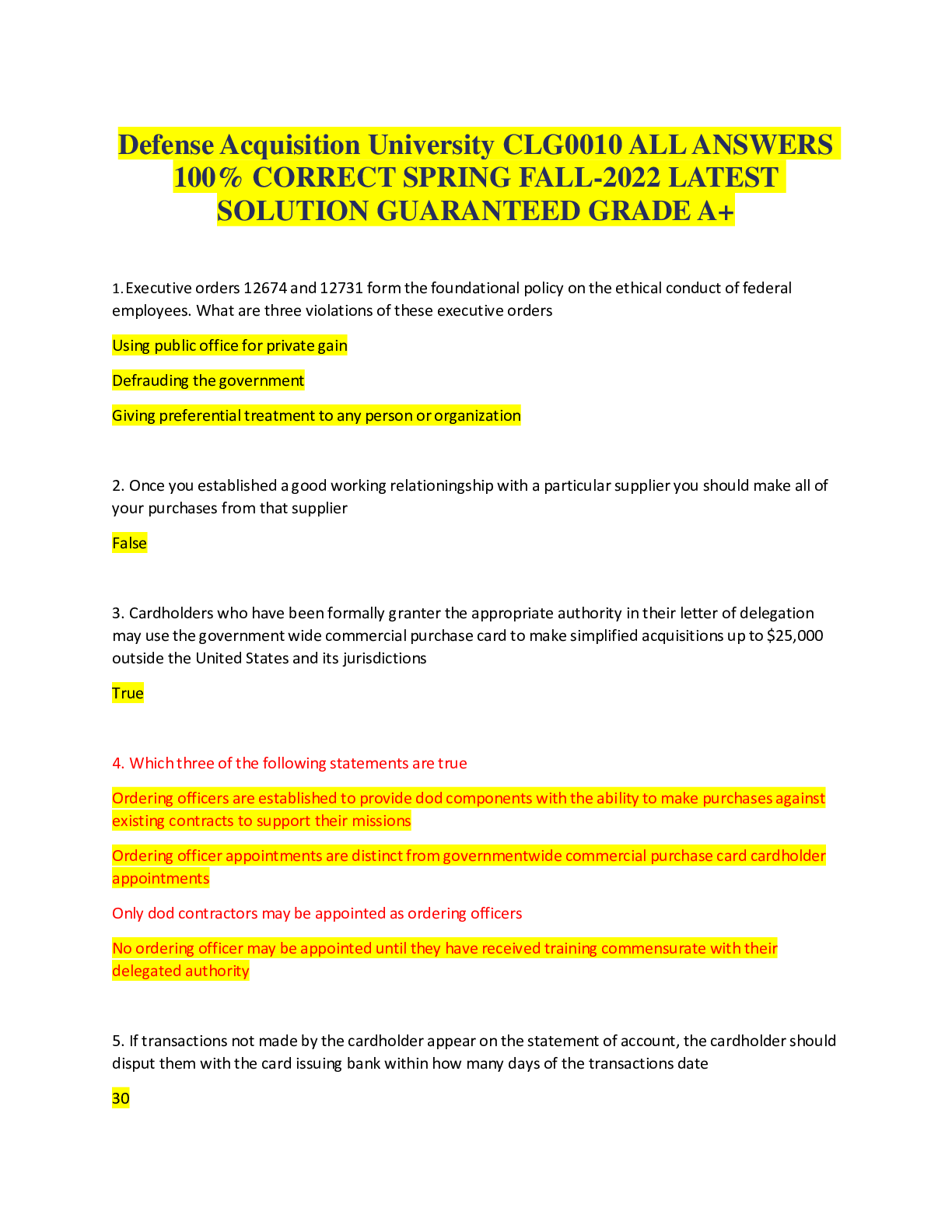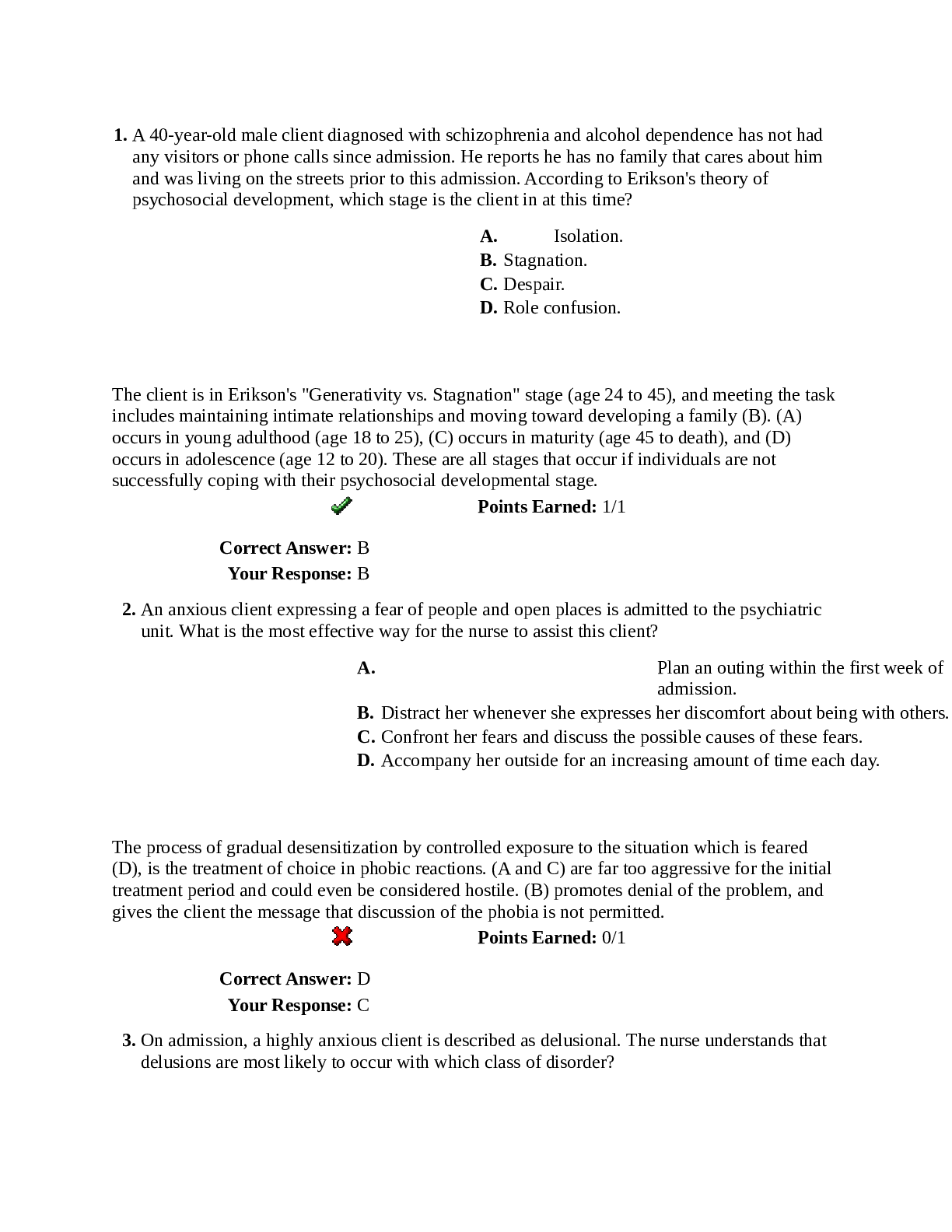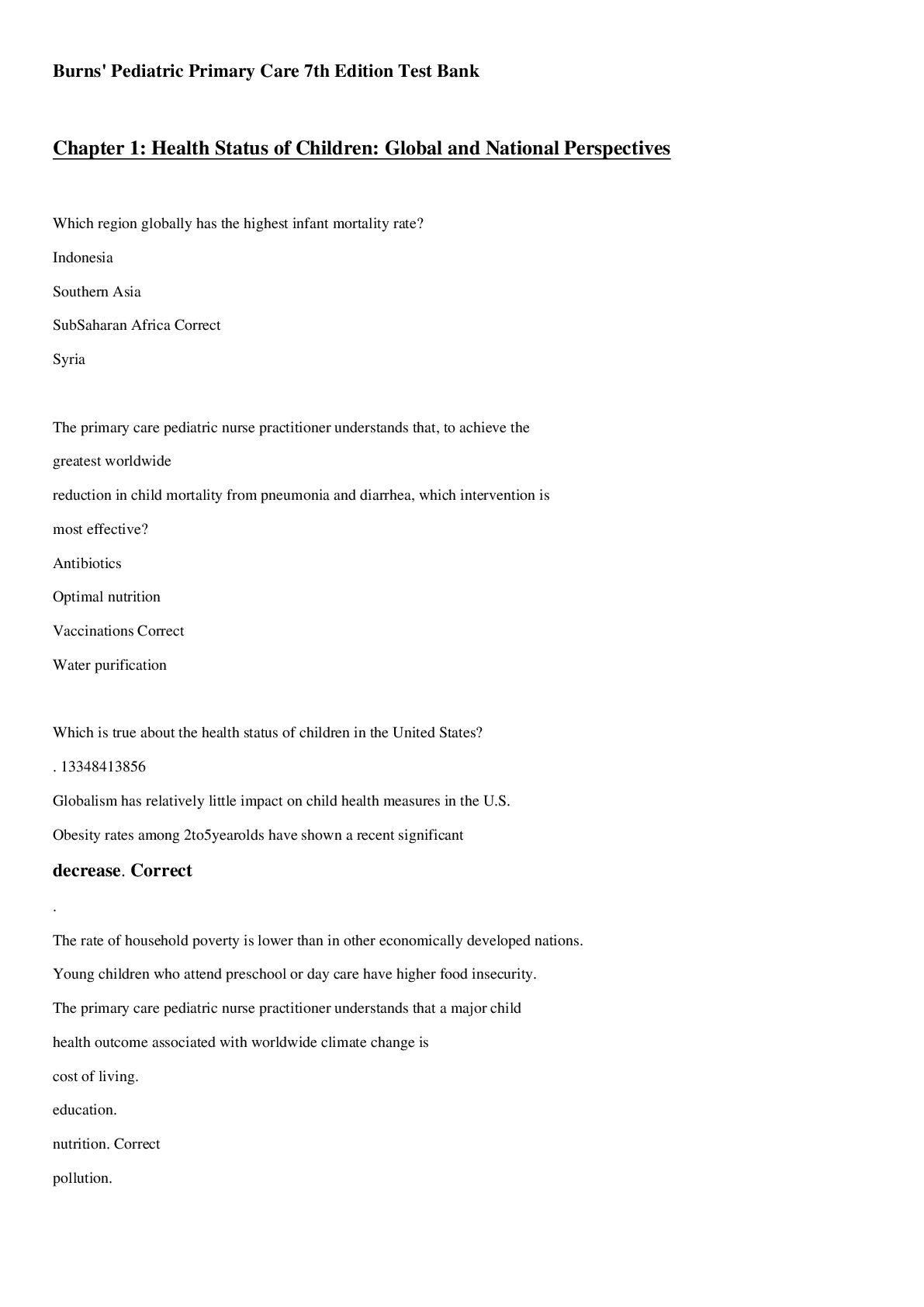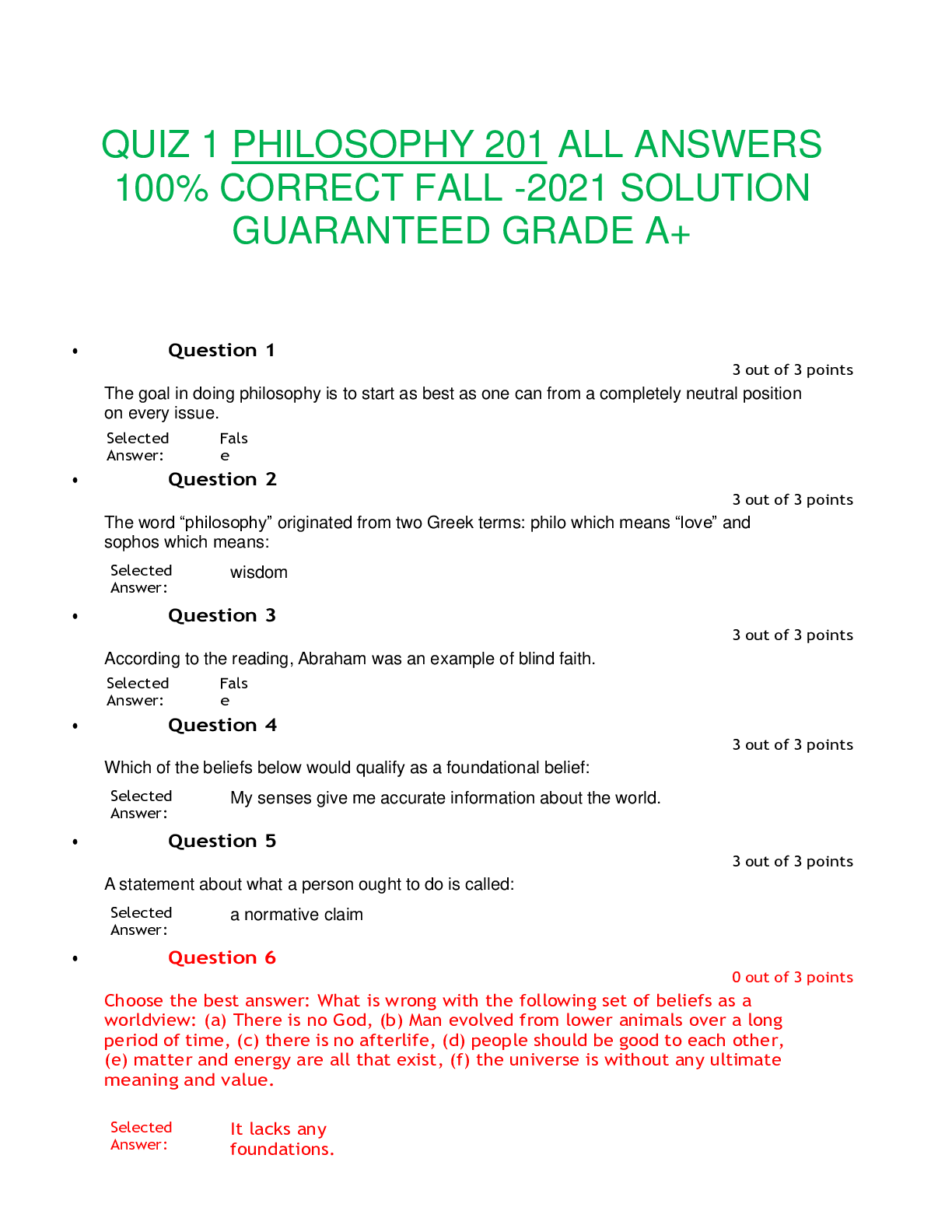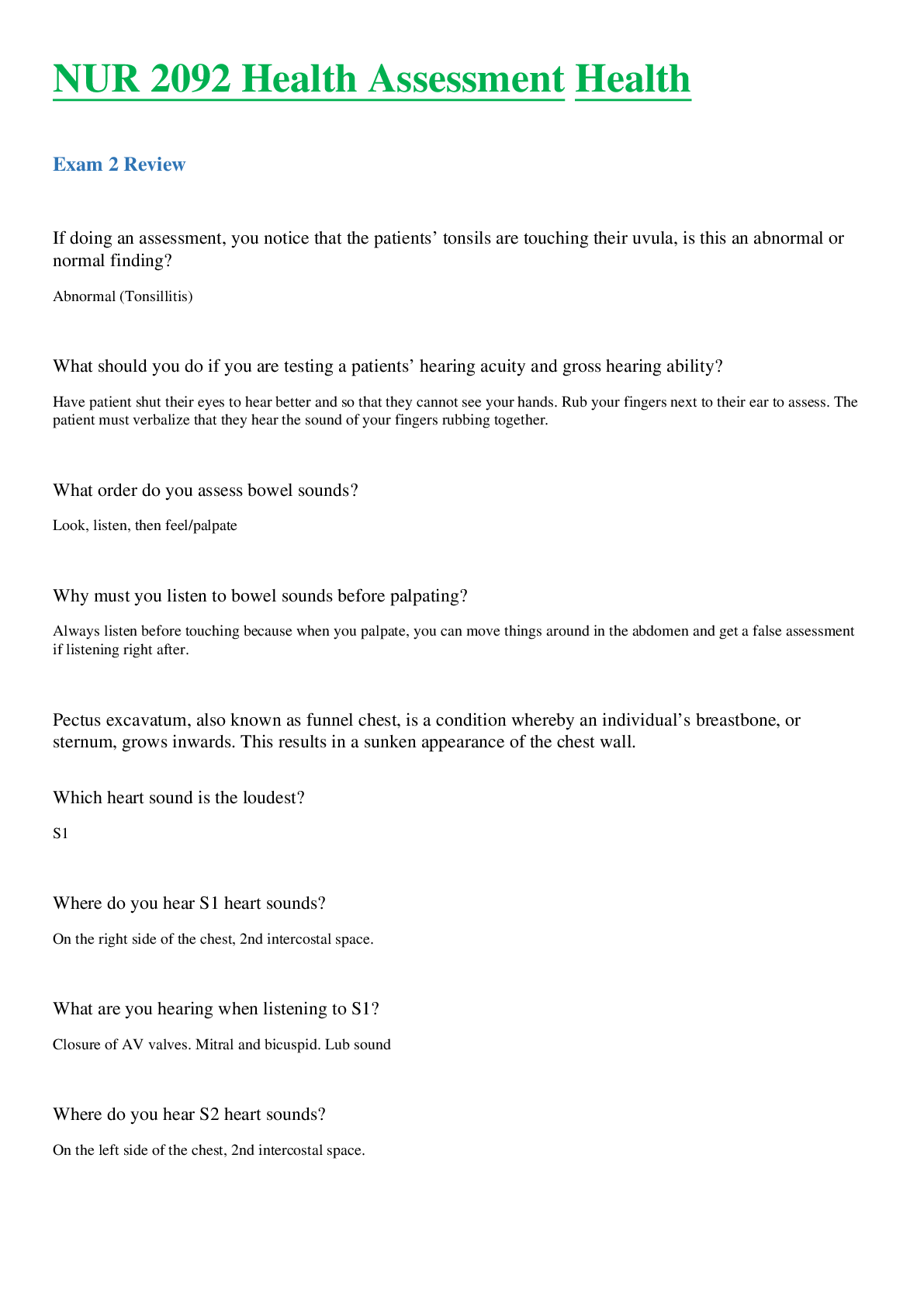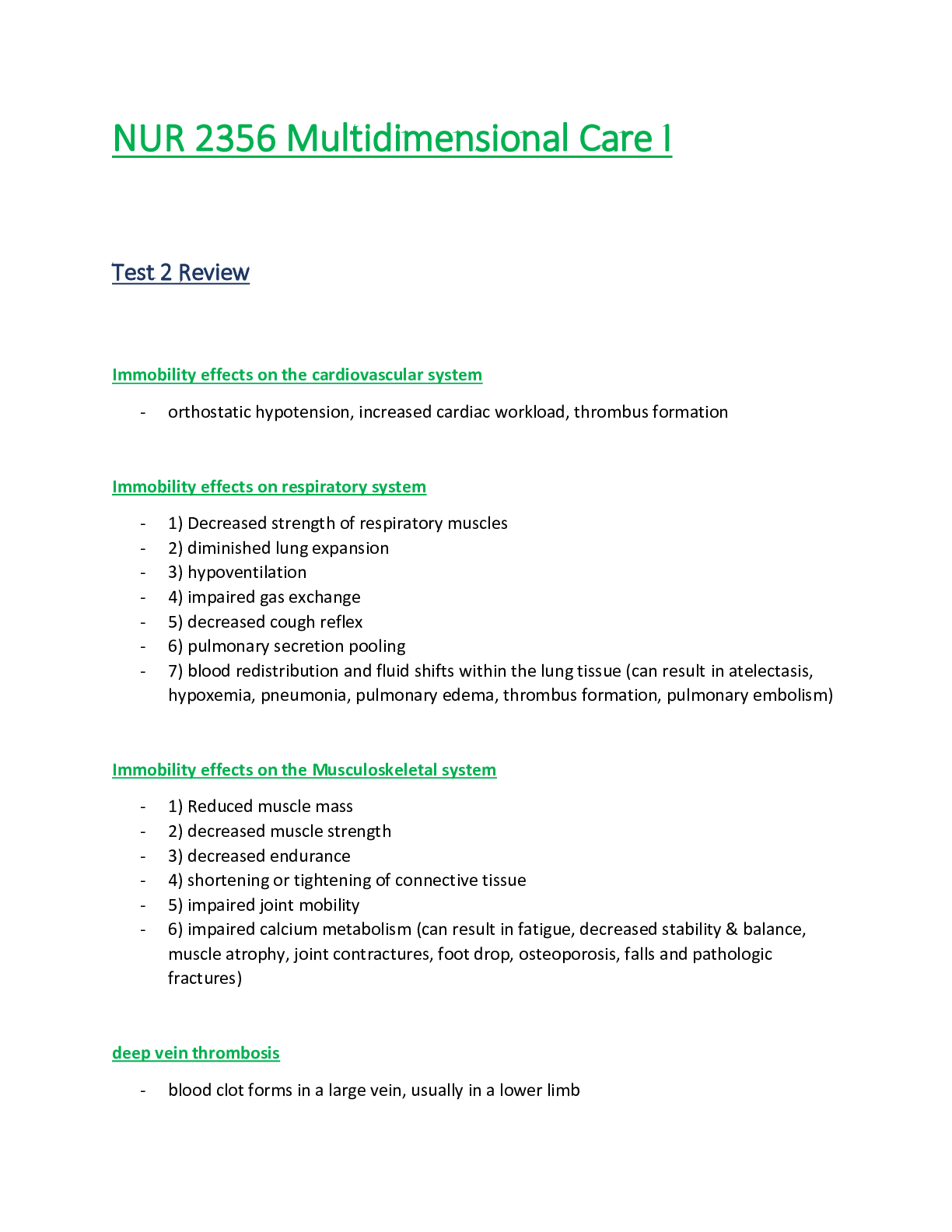*NURSING > EXAM REVIEW > NR 599 midterm review ALL ANSWERS 100% CORRECT SPRING FALL- 2022 LATEST SOLUTION GUARANTEED GRADE A+ (All)
NR 599 midterm review ALL ANSWERS 100% CORRECT SPRING FALL- 2022 LATEST SOLUTION GUARANTEED GRADE A+
Document Content and Description Below
General principles of Nursing Informatics • Verbalize the importance of health information systems with clinical practice. • Have knowledge of types and clinical and administrative uses of healt ... h information systems. • Ensure confidentiality of protected patient health information. • Assure access control in the use of health information systems. • Informatics: Science and art of turning data into info. • Nursing Informatics ANS: The specialty that integrates nursing science with multiple information and analytical sciences to identify, define, manage, and communicate data, information, knowledge, and wisdom in nursing practice. o Nursing Informatics supports nurses, consumers, patients, the inter-professional healthcare team, and all other stakeholders in their decision making in all roles and settings to achieve desired outcomes. o 2 Levels NI practice: generalists and informatics-nurse specialists. Knowledge • Awareness and understanding of a set of information and ways that information can be made useful to support specific task or arrive at a decision • Information that’s synthesized so that relationships are identified and formalized. • Processed information that helps to clarify or explain some portion in our environment or world that we can use a as basis for action or upon which we can act. • Often affected by assumptions and central theories of a scientific discipline and is derived by discovering patterns of relationships between different clusters of information. • Answers questions of “why” and “how” • Data – uninterpreted items, often referred to as data elements. An example might be a person’s weight. Without additional data elements such as height, age, overall well-being it would be impossible to interpret the significance of an individual number. • Information – a group of data elements that have been organized and processed so that one can interpret the significance of the data elements. o For example, height, weight, age, and gender are data elements that can be used to calculate the BMI. The BMI can be used to determine if the individual is underweight, overweight, normal weight or obese. • Knowledge - is built on a formalization of the relationships and interrelationships between data and information. A knowledge base makes it possible to understand that an individual may have a calculated BMI that is over 30 and not be obese. • At this time, several automated decision support systems included a knowledge base and a set of rules for applying the knowledge base in a specific situation. o For example, the knowledge base may include the following information. A fever or elevated temperature often begins with a chill. At the beginning of the chill the patient’s temperature may be normal or even sub-normal but in 30 minutes it is likely the patient will have spiked a temp. A rule might read: if a patient complains of chills, then take the patient’s temperature and repeat in 30 minutes. Wisdom • Appropriate use of data, information, and knowledge in making decisions and implementing nursing actions. • Guides the nurse in recognizing the situation at hand based on patients’ values, nurse’s experience, and healthcare knowledge. • Implies a form of ethics, or knowing why certain things or procedures should or should not be implemented in healthcare practice. • Includes the ability to integrate data, information, and knowledge with professional values when managing specific human problems. • The use of knowledge and experience to heighten common sense and insight so as to exercise sound judgment in practical matters. • Thought to be the highest form of common sense, resulting from accumulated knowledge. • Ability to apply viable and valuable knowledge, experience, understanding, and insight while being prudent and sensible. • Appropriate use of knowledge to solve human problems. Scientific Underpinning • The scientific underpinnings of practice provide the basis of knowledge for advanced nursing practice. • These scientific underpinnings include sciences such as biology, physiology, psychology, ethics, and nursing. • The sciences underpinning nursing informatics: Nursing science, information science, and computer science • The advent of nursing science, specifically middle-range nursing theories, expanded the discipline of nursing. Thorough understanding of nursing theory provides a solid foundation for advanced nursing practice. • The importance of using science-based concepts to evaluate and enhance health care delivery and improve patient outcomes. The Foundation of Knowledge Model • Model that proposes that humans are organic information systems constantly acquiring, processing, and generating information or knowledge in both their professional and personal lives. • Involves integrating four main kinds of knowledge, which are: knowledge acquisition, knowledge dissemination, knowledge generation and knowledge processing. o Knowledge worker: working with info. And generating info and knowledge as a product. o Knowledge acquirer: Providing convenient and efficient means of capturing and storing knowledge. o Knowledge engineers: Designing developing, implementing, and maintaining knowledge. o Knowledge managers: Capturing and processing collective expertise and distributing it. o Knowledge developers and generators: Changing and evolving knowledge based on the tasks at hand and the information available. • With time, we begin to transform our experiences and applied knowledge into it highest form known as...wisdom. • Knowledge is a powerful tool and that nurses focus on information as a key building block of knowledge. Computer science • Studies the theory underpinning information and computation and their implementation in computer systems. • Looks at how the human mind works from an information processing perspective. • Studies the theoretical foundations of information and computation and their implementation and application in computer systems. • Study of storage/memory, conversion and transformation, and transfer or transmission of information in machines. • Algorithms are detailed, unambiguous action sequences in the design, efficiency and application of computer systems, whereas practical implementation problems deal with the software and hardware. • Facilitates the acquisition and manipulation of data and information by nurses, who can then synthesize these into evolving knowledge and wisdom base. Cognitive science • Study of thought, learning, and mental organization, which draws on aspects of psychology, linguistics, philosophy, and computer modeling. • Interdisciplinary field that studies the mind, intelligence, and behavior from an information processing perspective. Information science • Deals with the retrieval and management of information as well as human-computer interactions. • Studies the application and usage of information and knowledge in organizations and the interface or interaction between people. • Concerned with the input, processing, output, and feedback of data and information through technology integration with a focus on comprehending the perspective of the stakeholders involved and then applying IT as needed. • An interdisciplinary, people-oriented field that explores and enhances the interchange of information to transform society, communication science, computer science, cognitive science, library science, and the social sciences. • Encompasses aspect of computer science, cognitive science, social science, communication science, and library science to deal with obtaining, gathering, organizing, manipulating, managing, storing, retrieving, recapturing, disposing of, distributing, and broadcasting information. • Studies everything that deals with information and can be defined as the study of ISs. • Enables the processing of information. • Links people and technology • Impacts information interfaces, influencing how people interact with information and subsequently develop and use knowledge. Standard Terminology (Week 1) • Standardized terminologies (STs) contribute to the development of knowledge because they ensure that all professionals share the same understanding or meaning of a given concept, to clarify communication, facilitate research, and provide structure for decision support tools and EHRs. • As you look at the Foundation of Knowledge model, STs support knowledge acquisition, dissemination, generation, and processing. • Structured controlled languages developed to represent concepts in a given domain in a clear, unambiguous fashion that conveys the exact same meaning for data, information, and knowledge across settings. • Guidelines addressed aspects that include content, concepts, and identification of concepts, hierarchy, relationships and formal definitions. • Are based upon concepts rather than terms and allow for growth over time. • Current Terminology: o Nomenclature refers to a system of rules and procedures for adding names used in an art or science, such as nursing. o Classification systems that capture categories, which are then used to determine costs or outcomes but are insufficient in detail for clinical documentation purposes. o Taxonomy which uses classification according to a predetermined system, with the resulting catalog used to provide a conceptual framework for discussion, analysis, or information retrieval. o Data set which refers to a named collection of data consisting of individual information organized in a prescribed fashion. • International Statistical Classification of Diseases and Related Health Problems (ICD) and Current Procedural Terminology (CPT) provides a description and a classification of known diseases and injuries. o Collection of morbidity and mortality statistics o Automated clinical decision support o Assignment of codes to medical diagnoses and procedures assoc. with hospital utilization in the US. • It improves communication, supports data reuse, contributes to the further development of nursing knowledge and provides a framework for EHRs. Informatics Competencies (Week 2) • Information Literacy: Refers to the use of digital technology to locate, navigate, manage, integrate, evaluate, create, and effectively communicate in a rapidly changing healthcare environment. The most important aspects of information literacy reflect information discovery, retrieval, and delivery as well as the ability to acquire, process, generate, and disseminate knowledge in ways that help those managing the knowledge reevaluate and rethink what an individual understands. o Ability to identify when information is needed as well as the skills to find, evaluate, and effectively use the same o Evaluation of online resources for quality o Able to search literature databases effectively • Computer Literacy o Basic familiarity with computer uses and common applications o Ability to navigate hyperlinks o Able to set up and use a database to collect and retrieve information • Clinical Information Management o Uses clinical decision making (CDS) and system safeguards to protect patients and protected health information (PHI) o Able to request and evaluate reports for the purpose of informed decision making o Participate in the selection, design, and evaluation of clinical information systems and patient-care technologies o Uses available technologies to appropriately and effectively communicate Health literacy (Week 2) • Degree to which individuals have the capacity to obtain, process, and understand basic health information and services needed to make appropriate health decisions. • Is dependent on individual and systemic factors: Communication skills of lay persons and professionals. • Is a major goal of Healthy People 2010 Meaningful Use (Week 3) • The American Recovery and Reinvestment Act of 2009 specifies 3 main components of meaningful use: o Use of certified HER in a meaningful manner, such as e-prescribing o Use of certified HER tech. for electronic exchange of health info. to improve quality of health care o Use of certified HER tech. to submit clinical quality and other measures. • Defined by the use of certified EHR technology in a meaningful manner (for example electronic prescribing); ensuring that the certified EHR technology connects in a manner that provides for the electronic exchange of health information to improve the quality of care. • Developed as an incentive program to assure that EHRs are used according to standards that achieve quality, safety, and efficiency measures • Staged in 3 steps o Stage 1: baseline for electronic data capture and info sharing o Stage 2 & 3 continues to expand on this baseline and be developed through future rule making. Patient-centered Information Systems • EMRs, aggregate information systems, patient unique identifiers. • Aggregated data are used for the generation of routine reports and indicators, and for strategic planning and guidance within the health system. • Focused on collecting data and disseminating info related to direct care. • Most commonly types found in healthcare organizations: o Clinical documentation systems o Pharmacy info systems o Laboratory info systems o Radiology info systems. Clinical Decision Support Systems (CDS) • Provides clinicians, staff, patients or other individuals with knowledge and person-specific information, intelligently filtered or presented at appropriate times, to enhance health and health care. • CDS encompasses a variety of tools to enhance decision-making in the clinical workflow. o These tools include computerized alerts and reminders to care providers and patients; clinical guidelines; condition-specific order sets; focused patient data reports and summaries; documentation templates; diagnostic support, and contextually relevant reference information, among other tools. • Provides HIT functionality that builds upon the foundation of an EHR to provide persons involved in care processes with general and person-specific information, intelligently filtered and organized, at appropriate times, to enhance health and health care • Promotes accurate medical diagnoses and suggest appropriate medical and nursing interventions based on patient data. Electronic Medical Records • Electronic version of a patient’s medical history, that is maintained by the provider over time, and may include all of the key administrative clinical data relevant to that persons care under a particular provider, including demographics, progress notes, problems, medications, vital signs, past medical history, immunizations, laboratory data and radiology report • Comput [Show More]
Last updated: 3 years ago
Preview 1 out of 20 pages

Buy this document to get the full access instantly
Instant Download Access after purchase
Buy NowInstant download
We Accept:

Reviews( 0 )
$9.50
Can't find what you want? Try our AI powered Search
Document information
Connected school, study & course
About the document
Uploaded On
Apr 11, 2022
Number of pages
20
Written in
All
Additional information
This document has been written for:
Uploaded
Apr 11, 2022
Downloads
0
Views
144


